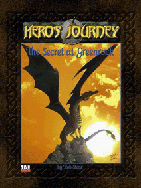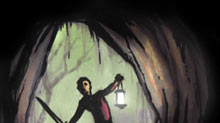by Demian Katz
 Many times in my life, I've picked up a fantasy novel and attempted to
read it. Nine times out of ten, I haven't made it past the first fifty
pages. It rarely seems worth the effort of plodding through dozens of
vaguely-described locations and unmemorably-named archetypical heroes
just to revisit a storyline that's been beaten into the ground again
and again since prehistoric times. When I started reading Citizen Games' The Secret
at Greenrock,
the first in a series of six adventures set in the land of Myrra, I
soon realized that it was another one of those adventures. A lot
of
unfamiliar names are bandied about, but in the end, it's a very old
story with very little meat on its bones. In fact, my first
inclination is to describe it as "a whole lot of nothing." However,
considering that it's 32-pages long and sells for $8.95, a better
description would probably be "a relatively scant amount of expensive
nothing."
Many times in my life, I've picked up a fantasy novel and attempted to
read it. Nine times out of ten, I haven't made it past the first fifty
pages. It rarely seems worth the effort of plodding through dozens of
vaguely-described locations and unmemorably-named archetypical heroes
just to revisit a storyline that's been beaten into the ground again
and again since prehistoric times. When I started reading Citizen Games' The Secret
at Greenrock,
the first in a series of six adventures set in the land of Myrra, I
soon realized that it was another one of those adventures. A lot
of
unfamiliar names are bandied about, but in the end, it's a very old
story with very little meat on its bones. In fact, my first
inclination is to describe it as "a whole lot of nothing." However,
considering that it's 32-pages long and sells for $8.95, a better
description would probably be "a relatively scant amount of expensive
nothing."
It's hard to even begin to convey how poor the design of this
module is, but the majority of its flaws revolve around one central
problem: poor distribution of information. For the most part, the
adventure doesn't provide nearly enough background material on
anything. It drops a lot of names, but it doesn't bother to tell the
GM what most of them actually mean; in fact, some of the major races
present in the adventure are left completely undescribed.
Characterization is also disastrously poor. The author apparently
seems to have intended for the adventure's NPCs to play significant
roles in the storyline, but none of them are really described in enough
detail to give the GM anything interesting to work with. Although
three entire appendices are filled with (obviously computer-generated)
NPC statistics, only one of these twenty-one characters actually comes
with a textual description. As if this weren't bad enough, the
characters aren't even equipped -- the statistics simply list the total
value of each individual's possessions in gold pieces. In any case,
what good are character stats without accompanying information on
motivation, quirks and other such details?
Although lapses of detail like this are infuriating, the
adventure's problem isn't always inadequate information; sometimes the
problem is just the opposite. When relatively meaty information is
provided, it is provided in excessive quantities. There's an entire
appendix, for example, which contains a translation of some
hieroglyphics found in one of the rooms in the adventure's dungeon.
This is a waste of space, since even if the party bothered trying to
read the carvings (which isn't necessarily all that likely), they
wouldn't want to listen to the GM reciting two dense pages of
unbelievably boring pseudo-history. There's also an introductory
passage about some people in some boat landing in some place, and while
it contains just about the most detailed prose in the entire module, it
has no real bearing on anything apart from describing a moment in the
ancient history of the land that provides the setting for the
adventure.
Even if the book didn't have massive problems in the
information department, there would be little reason to recommend it.
From the very start, it's hard to determine the player characters'
motivation. The adventure begins with the party arriving by boat in a
town on Myrra, which, combined with the adventure's relatively high
experience requirements, suggests to me that the author's intent was
for the GM to bring some PCs from an established campaign into this
module's new world. However, all of the adventure hooks provided
suggest that the party has lived in Myrra all along. Following this
bit of confusion is a gratuitous barroom brawl, a two in six chance of
a gratuitous encounter with vaguely-detailed roguish NPCs and, at last,
the assignment of a mission to the party by a vaguely-detailed and
either ominous or honorable (depending on how you interpret the text)
Guild (with a capital "G"). This mission is to investigate the
disappearance of a group of "kelnar," better known as dwarves, who
vanished in the mining town of Greenrock.
Once the party accepts this quest (and God save the GM whose
party decides not to accept), they set off on an overland journey
filled with vague characters and events which the players are unlikely
to notice or understand. There's a saboteur, for example, but she
makes most of her sabotage look accidental or monster-related, and
since she ends up getting captured by hostile beasts before the PCs
even have reason to believe that she exists, one has to wonder why she
was even included in the story. There are also some members of the
Guild which assigned the mission who are secretly sent to ensure that
the party doesn't chicken out. This seems rather odd. If the Guild is
this powerful, why do they need the PCs to do their work for them? And
if this is a test of loyalty, why not just say so? Ultimately, the
only character whose purpose is clear is Doc Davitori, a comic-relief
dwarf (err, kelnar) who exists solely to constantly irritate everybody.
Once the party reaches Greenrock, they find a crevice to crawl
into, and the dungeon exploration begins. Unfortunately for everyone
involved, much of the dungeon is about as exciting as this sample room:
16. Large Cavern
The cavern ceiling is approximately 150 feet high. The upper reaches of the ceiling of this cavern cannot
be seen with regular torches. To the right of the
entrance is a large pool of water (approximately 50 feet across).
In the center of the pool is a large stone.
That's the complete room description. A ceiling, some water, and a
rock. That's it. Admittedly, most of the other rooms at least
include, say, an Ochre Jelly in addition to the water and the rock, but
you won't find much in the way of thrilling design elements here.
Ultimately, if the party happens to wander into a particular
room and decides to cast a "speak with dead" spell and manages to solve
the resulting incoherent riddle and decides to act upon this vague
information, they might actually rescue an ancient and good dragon from
imprisonment, though they're unlikely to understand the significance of
their actions unless they also happen to wander into a different
particular room and discover the previously-mentioned hieroglyphics.
There is a "Quest Trap" to help things along, but this isn't described
in any useful amount of detail, so it's more or less up to the GM to
make sure that the party doesn't stray from the path.
As you can probably tell by now, the content of this module is
less than wonderful. Unfortunately, the presentation is considerably
better than the material deserves, so it's entirely possible that many
GMs will be fooled into making a regrettable purchase. The cover art
is attractive, and the interior art is decent, though the fact that the
work was done by four different artists lends a certain air of
inconsistency to the proceedings. Apart from the text itself, the four
dungeon maps are the book's weakest point. Not only are they rather
mediocre in appearance, but they also place north in the direction
where east traditionally belongs without including a compass rose to
clue the GM in to this fact. This can cause more than a little bit of
confusion if you're not prepared for it.
It's hard to look through a product like this one without
asking "what were they thinking?" The purpose of an adventure module
(especially one that costs $8.95) should be to provide material that
your average GM couldn't come up with off the top of his or her head.
With its computer-generated NPCs, empty dungeon chambers and
minimalistic plot, The Secret at Greenrock just doesn't serve that
market. If you need a quick adventure, just pick up any given issue of
Dungeon Magazine; it's guaranteed to contain many times more
content
than this module and cost a few dollars less as well. Perhaps the
later Myrra adventures are better than this one, but I can't quite
bring myself to look at them to find out.




